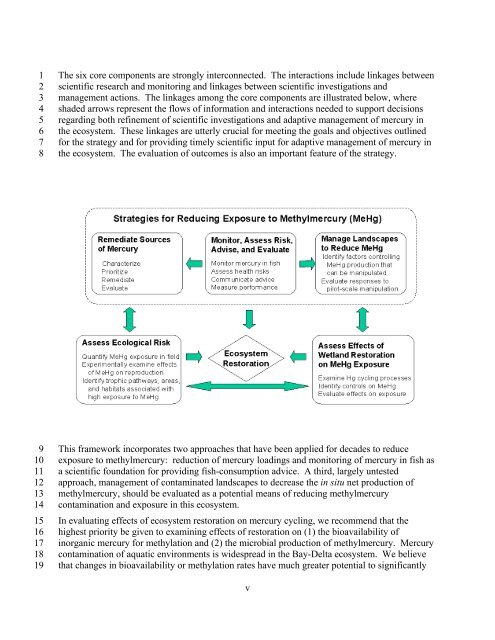Mercury Strategy for the Bay-Delta Ecosystem - CALFED Bay-Delta ...
Mercury Strategy for the Bay-Delta Ecosystem - CALFED Bay-Delta ...
Mercury Strategy for the Bay-Delta Ecosystem - CALFED Bay-Delta ...
Create successful ePaper yourself
Turn your PDF publications into a flip-book with our unique Google optimized e-Paper software.
1<br />
2<br />
3<br />
4<br />
5<br />
6<br />
7<br />
8<br />
9<br />
10<br />
11<br />
12<br />
13<br />
14<br />
15<br />
16<br />
17<br />
18<br />
19<br />
The six core components are strongly interconnected. The interactions include linkages between<br />
scientific research and monitoring and linkages between scientific investigations and<br />
management actions. The linkages among <strong>the</strong> core components are illustrated below, where<br />
shaded arrows represent <strong>the</strong> flows of in<strong>for</strong>mation and interactions needed to support decisions<br />
regarding both refinement of scientific investigations and adaptive management of mercury in<br />
<strong>the</strong> ecosystem. These linkages are utterly crucial <strong>for</strong> meeting <strong>the</strong> goals and objectives outlined<br />
<strong>for</strong> <strong>the</strong> strategy and <strong>for</strong> providing timely scientific input <strong>for</strong> adaptive management of mercury in<br />
<strong>the</strong> ecosystem. The evaluation of outcomes is also an important feature of <strong>the</strong> strategy.<br />
This framework incorporates two approaches that have been applied <strong>for</strong> decades to reduce<br />
exposure to methylmercury: reduction of mercury loadings and monitoring of mercury in fish as<br />
a scientific foundation <strong>for</strong> providing fish-consumption advice. A third, largely untested<br />
approach, management of contaminated landscapes to decrease <strong>the</strong> in situ net production of<br />
methylmercury, should be evaluated as a potential means of reducing methylmercury<br />
contamination and exposure in this ecosystem.<br />
In evaluating effects of ecosystem restoration on mercury cycling, we recommend that <strong>the</strong><br />
highest priority be given to examining effects of restoration on (1) <strong>the</strong> bioavailability of<br />
inorganic mercury <strong>for</strong> methylation and (2) <strong>the</strong> microbial production of methylmercury. <strong>Mercury</strong><br />
contamination of aquatic environments is widespread in <strong>the</strong> <strong>Bay</strong>-<strong>Delta</strong> ecosystem. We believe<br />
that changes in bioavailability or methylation rates have much greater potential to significantly<br />
v

















